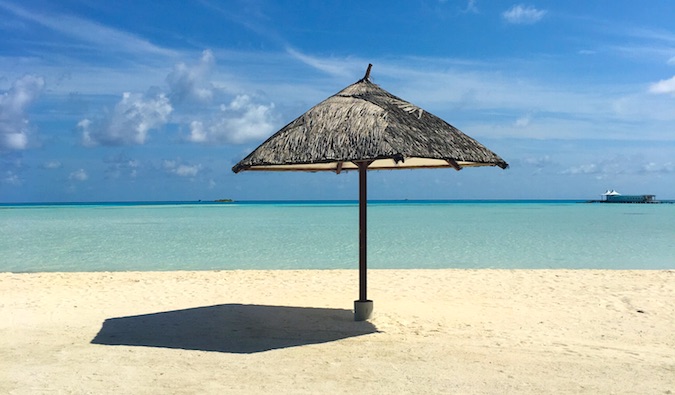
The Maldives conjure up images of pristine beaches, reef-ringed atolls, and luxurious bungalows on the water, where lucky guests can observe fish through glass floors and jump into the sea from their deck.
This island nation has always been on my “bucket list,” so when I decided to visit Sri Lanka and Dubai last month, the Maldives was a logical and obvious addition to my itinerary.
Especially, since there’s now a budget travel scene in the country.
In 2009, the Maldivian government allowed locals to open their own guesthouses and restaurants to tourists. Whereas before travelers were limited to the resort islands, now they can visit and stay on any local island they choose to. Suddenly, homestays, hotels, and guesthouses have started popping up everywhere!
It was a momentous shift in policy that finally allowed locals a piece of the economic tourist pie.
Though I wanted to experience everyday life, the aforementioned idyllic images rippled through my mind, and there was no way I could miss a chance at experiencing that. Splitting my nine-day visit into two parts, I decided to spend four days in a resort and five days on the “real” islands.
Life on the High End
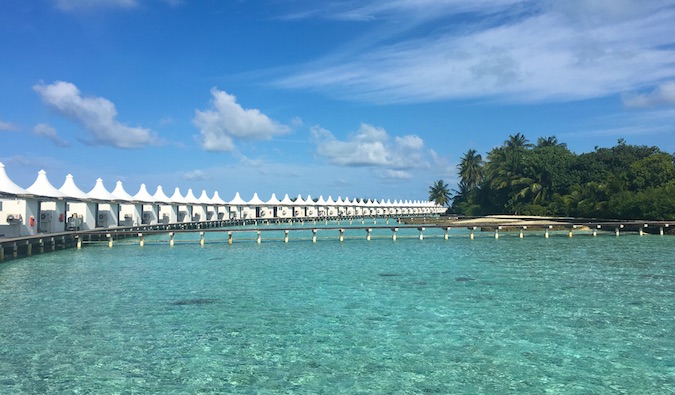
With a Dubai friend in tow, I landed at the Cinnamon Hakuraa Huraa resort, 150 km south of the capital, Malé. Like all resorts, the hotel is on its own private island that boasts over water bungalows, their own restaurant, bar, spa, and operated tours. (And, like most resorts here, meals and drinks are included in the cost of the room.) Cinnamon is on the lower end of the price spectrum, costing $356 USD per night, which, while not super budget, is a lot cheaper than other resorts like the Park Hyatt ($940 USD per night), the Taj ($945 USD per night), Komandoo Maldive Island Resort ($650 USD per night), the W ($1,288 USD), the Four-Seasons ($1,600 USD), or the St. Regis ($2,000 USD a night). (Note: Those high prices are why so many people save up hotel points for their trips!)
As I was itching for an overdue vacation and work detox, my visit was just what the doctor ordered: a tropical island with limited Internet and a friend whose job it was to keep me from working.
I spent my days trying not to burn myself on the beach, reading books (I highly recommend A Year of Living Danishly by Helen Russell), and drinking wine, stuffing my face, retiring for more reading and maybe a movie. Life on the island was easy. In the resort bubble, you don’t have to worry about getting around, meals, or what to do.
It was a vacation.
The staff was super friendly, they knew how to make a good drink, and there was always food around. Meals were buffet style (unless you paid extra for the romantic crab restaurant or the lunchtime cooking class, which I did. See the awesome meal I cooked in the picture below).
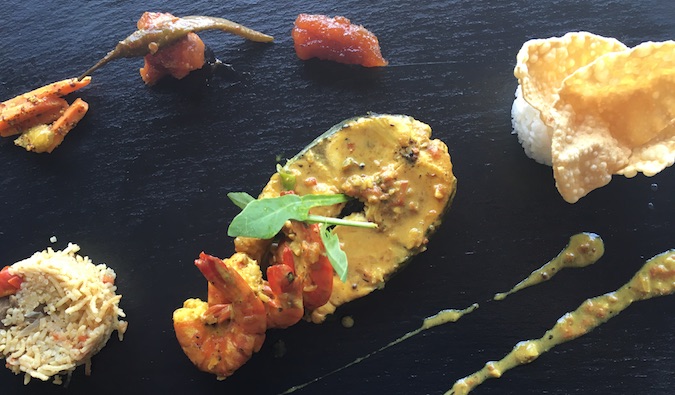
Taking advantage of some of the hotel’s tours, we went dolphin watching (so many dolphins!), snorkeled each day, and visited a couple of the nearby islands.
Since resorts in the country are geared toward families or couples, there are few solo travelers or non-couples outside the dive resorts. (My friend and I were the only non-couple on the island.) I found there wasn’t a lot of guest interaction but since everywhere there is on vacation, I’m not surprised.
But, after four days, my friend and I were both a bit ready to move on. I can only take vacation life for a few days before I get bored. The high life was what I thought it would be — relaxing opulence — but I was itching to see the real Maldives, life on the local islands, and talk to a few people!
Life the Way It Should Be
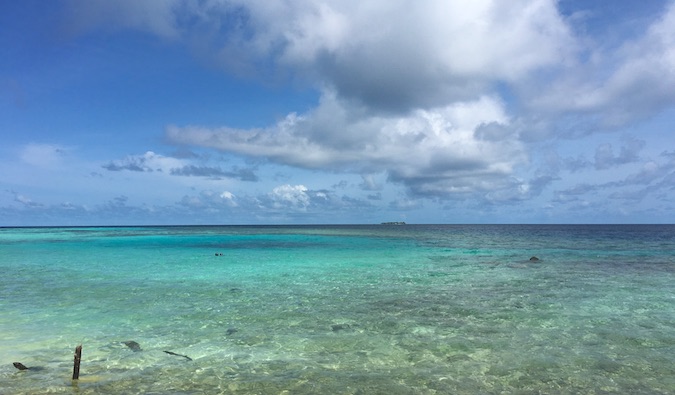
After returning to Malé and seeing my friend off at the airport, I hopped into a speedboat and headed to Maafushi, ground zero for the Maldives’ burgeoning independent travel industry, to start my island-hopping adventure.
It was a horrible place and I hope to never return.
Maafushi, once a sleepy little island, is now the victim of uncontrolled development. There are hotels going up left and right, boats making frequent trips to Malé to pick up tour groups, and one small, increasingly crowded, overbuilt beach. The few restaurants on the island cater mostly to tourists, and outside the area cleaned up for visitors, it’s one trash-covered dump. You can see the writing on the wall — this place is the next Ko Phi Phi. As a guesthouse owner on another island said, “Soon there will be no more locals there. They will simply rent out their land and move to Malé.”
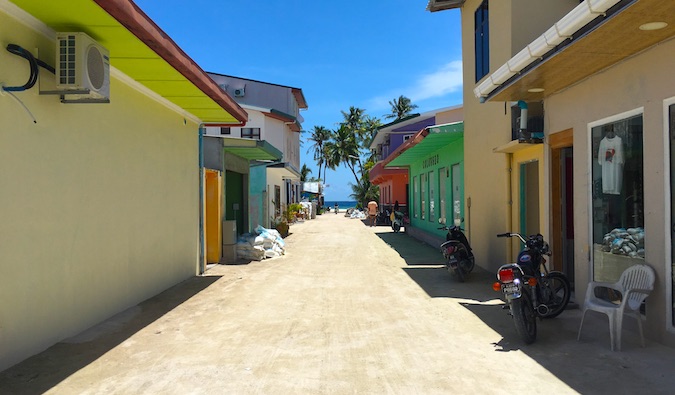
But Maafushi is good for a few things: diving, snorkeling, and acting as a launching pad to prettier, quieter islands like Gulhi and Fulidhoo.
After a couple of days, I escaped to Mahibadhoo. Kristin, our amazing solo female travel writer, stayed there a few years ago, and so I was eager to visit and check out the Amazing Noovilu, praised as “possibly the best guesthouse in the Maldives.” (It was really nice. A little expensive for my taste but the service, food, and activities offered by the staff was resort quality. Incredible attention to detail and I recommend staying there.)
Unlike Maafushi, I liked Mahibadhoo.
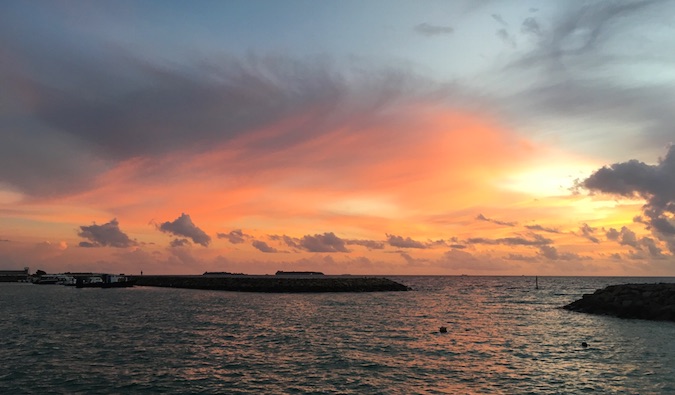
It was clean (local women volunteer to clean the island once a week), and the buildings were more colorful, featuring a rainbow of pastel-colored structures. There was more life here (I watched local soccer games each night), and, overall, the vibe was just nicer! The island, despite having speedboat access to Malé, has escaped (for now) the mass development of Maafushi. Though it doesn’t have a “bikini beach” (as the beaches for foreigners are called), there is good snorkeling right off shore (which is what I did), and it’s a launching pad for day trips to deserted atolls, sandbars, and quieter islands like Dhanbidhoo, Kalhaidhoo, and Isdhoo.
Though the islands the locals inhabit are adding guesthouses, they frequently aren’t set up for tourists. Ferry service is infrequent to all but a couple of the islands, and most don’t have many restaurants, or even beaches to lay on. There are a couple reasons for this.
First, bikini beaches exist for tourists. The Maldives is a Muslim country and, while there are public beaches, you need to be covered up for them. Most of the local islands don’t have white sandy beaches, so many built special ones just for the tourists that are hidden from view and visitors can be more scantily dressed (hence the bikini name).
Secondly, “eating out” isn’t a thing in the Maldives. Locals mostly cook for themselves. There are cafes but few restaurants. You usually eat at the guesthouses, who cook up meals (included in the price) for guests. However, you can get a lot of good food this way as many guesthouses cook up curried fish, rice, and other local delicacies. The fare is simple but very tasty.
And, while the communities are still trying to figure out how to deal with tourism, I was sad to leave and wish I had more time to explore the nooks and crannies of the atolls. Everyone here was friendly and curious and it would have been nice to get to dig deeper into local life and culture.
Travel Tips for the Maldives
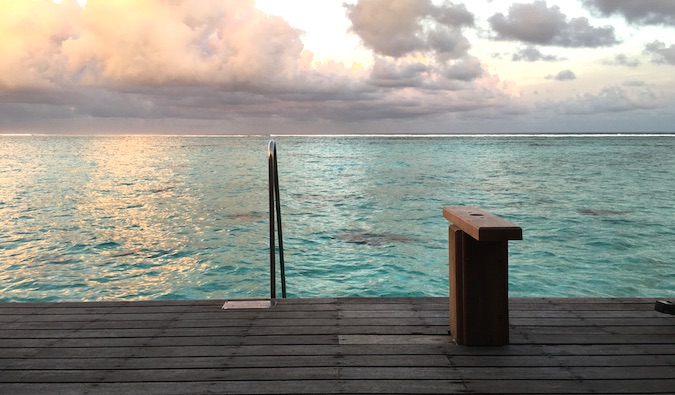
While the Maldives don’t have to break your budget, it’s important to know a few things before you go – or you’ll make some costly mistakes:
Ferries require planning (and don’t always come) – The Maldives’ atolls are served by a series of ferries from Malé. They run on opposite days (to Maafushi on Monday, back to Malé on Tuesday) and rarely on Friday (it being the Muslim sabbath). You can jump from Malé to an atoll’s capital island then to smaller, nearby islands in the chain. The ferry is only $2-5 USD depending on distance.
But they don’t always show up. I was meant to take one that never arrived. They only travel once a day (in the morning — don’t oversleep), so if one doesn’t come, you’ll have to fork over money for a speedboat ($25 USD, or $160 USD to rent an entire one) or wait for the next day’s departure.
When you are visiting the Maldives, research the ferries beforehand so you know when and where you can go next. Island hopping is very difficult without planning. I messed up by not looking at the ferry system before I arrived; as a result, I missed a few islands I wanted to visit. I wrongly assumed there would be frequent ferries between the islands — I was sorely mistaken.
Inter island ferry schedules can be looked up here.
Speedboats are your friend – From Malé, you can take speedboats to a few of the nearby capital islands of surrounding atolls. They cost $25-30 USD but also leave infrequently, usually once a day (Maafushi is the only island I found with multiple speedboat departures).
There is no alcohol – As the Maldives is a Muslim country, you can’t get alcohol anywhere in the country, except on the resort islands which have a special exemption. (Though there is a special barge for drinking off Maafushi, at the time of my visit, it was being repaired for the foreseeable future.)
Flying is not cheap – Flying is incredibly expensive here. Flights from Malé to surrounding atolls can cost up to $350 USD each way. Skip this.
Take lots of USD – Though the Maldives has its own currency, US dollars are widely accepted, and you often get a better price if you pay in USD. This varies from one restaurant or shop to another, so I carried both currencies with me and paid in whatever currency had a lower price. (Though you’re talking the difference of 50 cents, every penny counts!)
Moreover, Maldivian ATMs charge 100 MVR ($6.50 USD) per withdrawal. Taking cash or making one large withdrawal eliminates or reduces those fees (and so does having a bank that reimburses those fees).
And don’t worry – the Maldives is very safe. No one is going to steal all that cash. I never once felt uneasy about having lots of money on me.
Is it good for solo travelers?
Yes, if you just want to read, relax, and focus on you.
While you’ll see a lot of travelers in Malé heading to dive boats or bouncing from island to island, it’s all friends, couples, and families. Despite the cheap cost of travel, the Maldives is still not on the solo traveler radar.
Is the Maldives cheap?
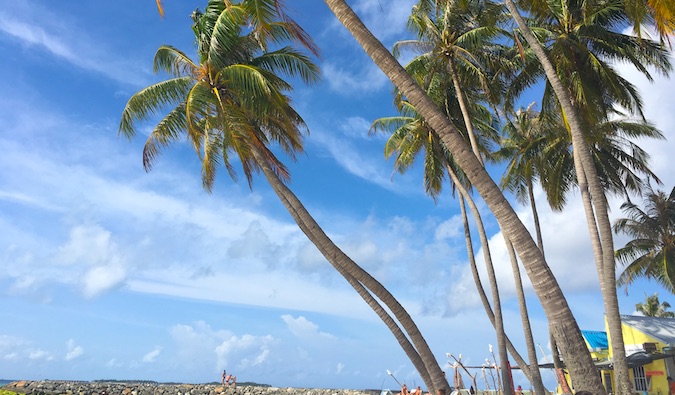
Yes, the Maldives is surprisingly cheap (except airfare). Though they import a lot of goods, if you stick to local ferries, guesthouses, and local food (fish, rice, curry), you can get by for $50-70 USD a day ($60-70 USD per day if you are solo, closer to $50 USD if you are splitting the cost of a room). Since there’s no alcohol on the islands, you don’t have to worry about drinking away your budget. Here are some typical costs:
- Single room in a local guesthouse: $40 USD per night
- Public ferry: $2-5 USD per ride
- Airport ferry to Malé: $1.50 USD
- Speedboats: $25-30 USD per ride
- Tea at local cafés: $0.33 USD
- Snorkel trips: $20-30 USD
- Diving for whale sharks: $100 USD
- Meals: $7-10 USD each
- Buffet dinners: $10- 15 USD each
- Sandwich on Male: $4-5 USD
- Bottle of water: $0.40-0.80 USD
In my four days, my biggest expense was the $120 USD I paid to rent a speedboat back to Malé when my ferry didn’t show up. I found the islands to be quite the bargain!
****
We think of the Maldives as a budget busting, high end place but they don’t have to be. The country is cheaper than some of the popular destinations in the Caribbean or even Southeast Asia! One day I hope return and spend more time island-hopping. There’s more I want to see and do here. I highly recommend visiting the Maldives before the islands become too overdeveloped, the beaches get swallowed up by the sea (climate change and coral bleaching were both hot topics with the locals I spoke with), or the world catches on to how budget friendly the country really is.
Note: Cinnamon Hakuraa covered the cost of the room at the resort (which included food and beverages). The rest of my trip, including my flight, was paid for entirely by me.
没有评论:
发表评论